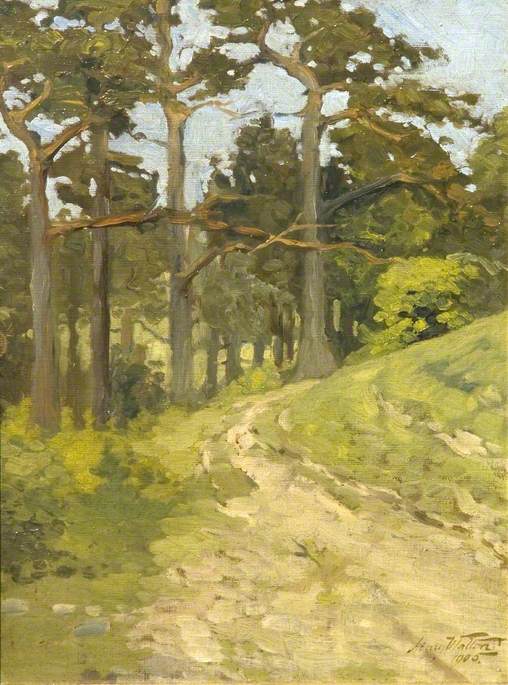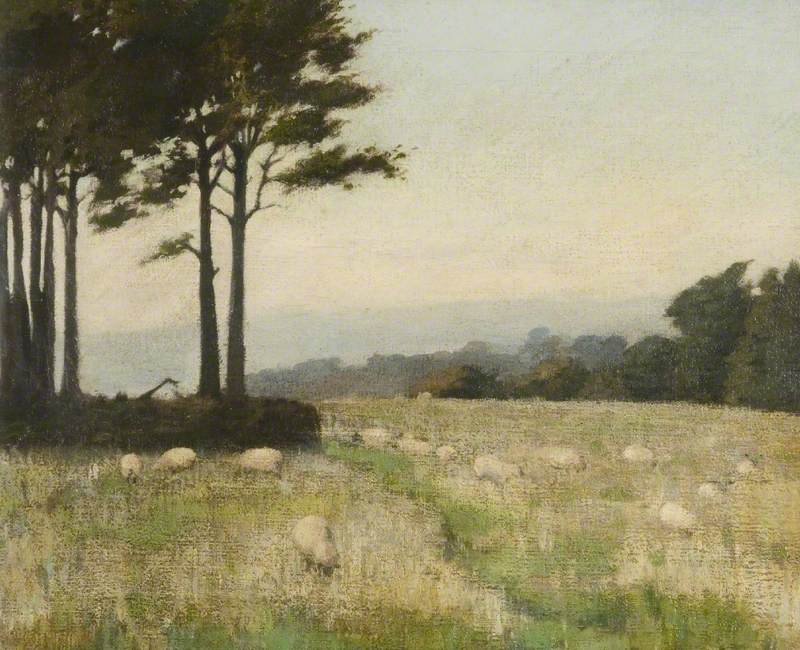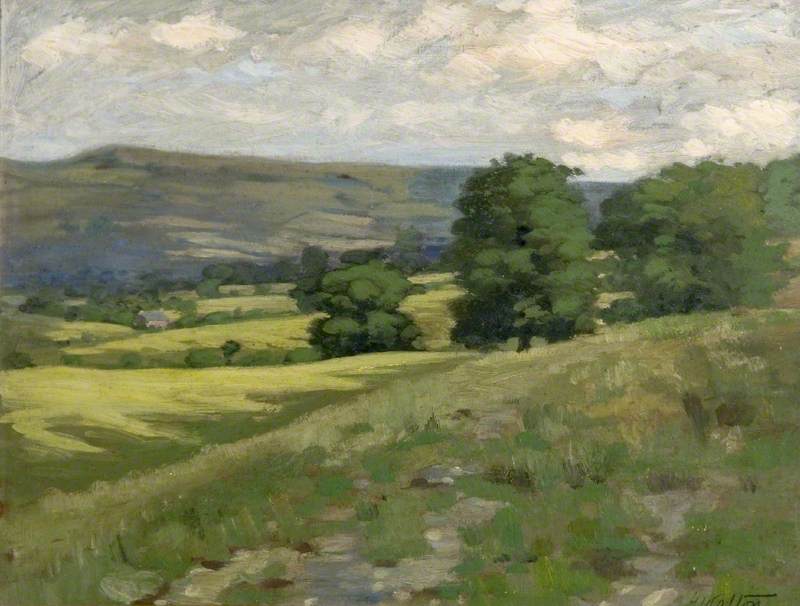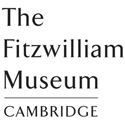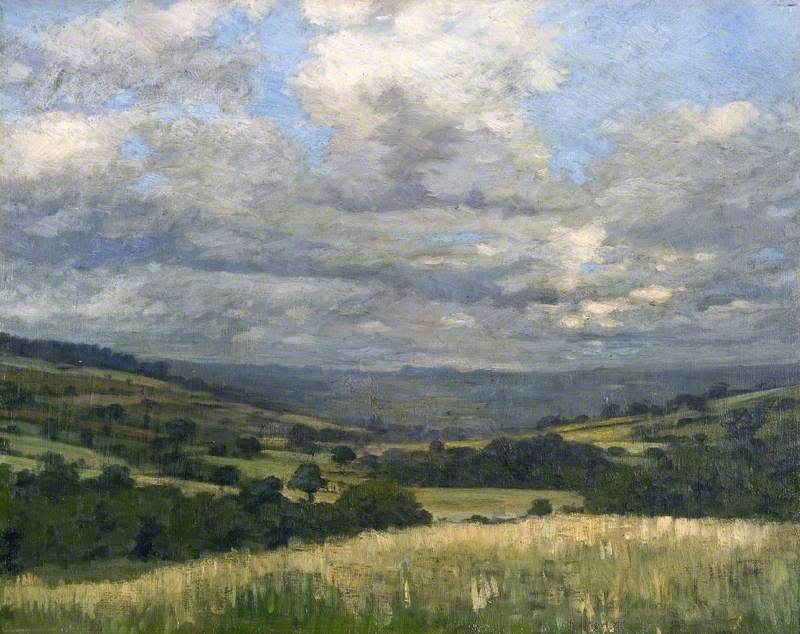
Henry Walton, painter and agricultural administrator, was born at Newark-on-Trent on 2nd November 1875, second of two children (after an elder sister) of Henry and Sophia Walton, née Crossley, who appears to have come from Bradford. His father was a brewer and maltster and, like his father Thomas before him, proprietor of the Clinton Arms Hotel, in the Market Place at Newark. A prominent local man and Conservative councillor, Henry senior (b.1832) was Mayor of the town in the year of his son’s birth but in 1884 died of heart failure, leaving his family fairly well-off. At the time of the 1891 census Henry junior, then 15, was living in Great Horton Road, Bradford, with his mother’s family, and was a student at the nearby Art College (then part of Bradford Technical College).
In September 1899, in Bradford, he married Gertrude Beatrice Blackburn (1877–1951), a local girl of similar prosperous middle-class background, who was also artistic and by 1901 they settled at the hamlet of Birdsmoor Gate, overlooking Marshwood Vale near Charmouth in West Dorset. By 1910 they moved to a larger house called Buckland Hill, closer to Marshwood: the 1911 census identifies each as ‘Artist’, with ‘Painter’ added as an office note and they were also reportedly involved in craft design (silver- and copper-work, leather, embroidery).
In both places Henry’s sister Emma then lived with them and was noted in 1901 and 1911 as of independent means, while Henry’s listing for jury eligibility calls him a ‘gentleman’ in 1910–1912 and a ‘designer’, 1913–1921. Their son Geoffrey, apparently an only child, was born on 8th October 1913.
Although still calling himself an ‘artist’ in 1911, Henry’s earlier move to Dorset soon involved him in agricultural matters, painting becoming a secondary and, in effect, amateur occupation. Probably through keeping poultry himself, in 1903 he became manager of the new Blackdown and Thorncombe Egg Collection Depot at Marshwood. This became affiliated to the National Poultry Organization Society after its foundation in 1905, by which he was subsequently employed as Secretary of the Blackdown Depot, a subsidiary to the main Dorset one apparently at Morcombelake six miles away. In 1911 he also appears to have been one of the founding organizers of the British Poultry Federation (see The Illustrated Poultry Record, July 1911, pp.442-44, which includes a portrait of him).
In February 1920, based on his ‘considerable experience as treasurer of an agricultural co-operative and farming’, Walton beat 178 other candidates to become first permanent secretary of the Hampshire Branch of the National Farmers Union. The salary was a substantial £350 p.a., rising to £500, and by early 1921 the family moved to Itchen Abbas to comply with his obligation to work from Winchester. He held the post until February 1935, after which the Waltons made their last move to nearby Itchen Stoke. In 1939 Henry was noted as a local agent there for Lawes Chemicals Ltd, major suppliers of agricultural fertilizers.
Bridport’s Coach House Museum has eight good landscape and figure subjects in oil by Henry Walton, and a portrait of an old man, all presented by his son in 1978. The Hampshire Cultural Trust has two landscapes and Newark a rather mechanical portrait of Edward Cooper, its Mayor in 1857: this is dated 1911 and Walton clearly copied it from a later Victorian photograph of the sitter in old age.
He appears to have exhibited only locally, but as yet the sole record of this is of a number of what were probably watercolours at the Winchester Art Club’s 14th annual exhibition in October 1934 (which included other work by Eric Ravilious and William Dring, for example; see Hampshire Telegraph, 12th October). The ‘Mrs Walton’ who showed ‘charming flower studies’ at the Winchester show in 1923 may have been Gertrude. She died on 25th January 1951, Henry still then being noted in her will administration as an ‘agricultural merchant’; he died on 16th November 1959.
Their son, Geoffrey, a literary scholar and critic, matriculated in 1932 from Downing College, Cambridge, where he was an early student of F. R. Leavis and subsequently contributed to his quarterly review, Scrutiny, between 1936 and its closure in 1953. He became a lecturer at the University College of the South-West (now Exeter University) before moving to posts in late-colonial and early independent Ghana, Nigeria and finally Uganda. He appears to have become a rather isolated figure in Africa and later returned to England (probably by the early 1970s), living first in Canterbury and then Lewes. When he died in Brighton on 12th December 2003 he left a significant legacy to Downing College.
Summarised from Art UK’s Art Detective discussion ‘Could the artist be Henry Walton (1875–1959)? If not Edward Cooper, Mayor of Newark in 1857, who is the sitter?’(information mainly provided by Osmund Bullock)
Text source: Art Detective
